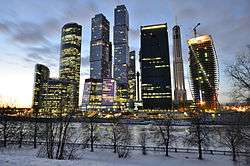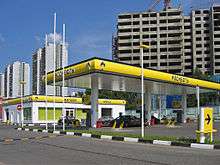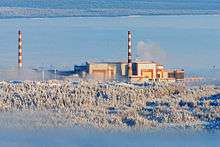Transport in Russia
The transport network of the Russian Federation is one of the world's most extensive transport network. The national web of roads, railways and airways stretches almost 7,700 km (4,800 mi) from Kaliningrad in the west to the Kamchatka Peninsula in the east, and major cities such as Moscow and Saint Petersburg are served by extensive rapid transit systems.
Russia has adopted two national transport strategies in recent years. On 12 May 2005, the Russian Ministry of Transport adopted the Transport Strategy of the Russian Federation to 2020. Three years later, on 22 November 2008, the Russian government adopted a revised strategy, extending to 2030.
The export of transport services is an important component of Russia’s GDP. The government anticipates that between 2007 and 2030, the measures included in its 2008 transport strategy will increase the export of transport services to a total value of $80 billion, a sevenfold increase on its 2008 value. Foreign cargo weight transported is expected to increase from 28 million tonnes to 100 million tonnes over the same period.

Rail transport
Russia has the world's second-largest railway network, second only to that of the United States,[1] with a total track length of 87,157 kilometres (54,157 mi) as of 2011. 86,200 kilometres (53,600 mi) of this uses a broad rail gauge of 1,520 mm (4 ft 11 27⁄32 in), while a narrow gauge of 1,067 mm (3 ft 6 in) is used on a 957-km (595-mile) stretch of railway on Sakhalin Island. Electrified track accounts for around half of the Russian railway network - totalling 40,300 kilometres (25,000 mi) - but carries the majority of railway traffic.[2]
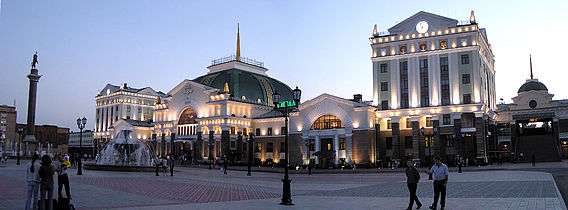
Russian Railways, the state-owned national rail carrier, is one of the world's largest transport companies, enjoying a monopoly over rail transport in Russia. Established in 1992, it employs an estimated 950,000 people, and accounted for 2.5% of the entire national GDP in 2009.[3][4] In 2007 alone, Russian Railways carried a total of 1.3 billion passengers[5] and 1.3 billion tons of freight[6] on its common-carrier routes.
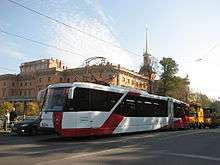
Rapid-transit systems
- Moscow Metro – 12 lines, 200 stations, 333.3 km
- Saint Petersburg Metro – 5 lines, 67 stations, 113.2 km
- Novosibirsk Metro – 2 lines, 13 stations, 15.9 km
- Nizhny Novgorod Metro – 2 lines, 14 stations, 18.8 km
- Samara Metro – 1 line, 10 stations, 12.7 km
- Yekaterinburg Metro – 1 line, 9 stations, 12.7 km
- Kazan Metro – 1 line, 10 stations, 15.8 km
Also there is a Metrotram system in Volgograd and three more cities with metro systems under construction:
Rail links with adjacent countries
Voltage of electrification systems not necessarily compatible.
- Norway – no – But Proposed Via Finland & Sweden – break of gauge 1,524 mm (5 ft)/1,435 mm (4 ft 8 1⁄2 in), or Murmansk – Kirkenes (10 km of 1,435 mm (4 ft 8 1⁄2 in) on the Norwegian side will probably be widened to 1,520 mm (4 ft 11 27⁄32 in)
- Finland – Yes — same gauge of 1,524 mm (5 ft)/1,520 mm (4 ft 11 27⁄32 in)
- Estonia – Yes — same gauge of 1,520 mm (4 ft 11 27⁄32 in)
- Latvia – Yes — same gauge of 1,520 mm (4 ft 11 27⁄32 in)
- Lithuania – Yes – same gauge of 1,520 mm (4 ft 11 27⁄32 in)
- Poland – Yes – Via Kaliningrad Oblast – break of gauge 1,520 mm (4 ft 11 27⁄32 in)/1,435 mm (4 ft 8 1⁄2 in)
- Belarus – Yes – same gauge of 1,520 mm (4 ft 11 27⁄32 in)
- Ukraine – Yes – same gauge of 1,520 mm (4 ft 11 27⁄32 in)
- Georgia – Yes – same gauge of 1,520 mm (4 ft 11 27⁄32 in)
- Azerbaijan – Yes – same gauge of 1,520 mm (4 ft 11 27⁄32 in)
- Kazakhstan – Yes – same gauge of 1,520 mm (4 ft 11 27⁄32 in)
- China – Yes – break of gauge 1,520 mm (4 ft 11 27⁄32 in)/1,435 mm (4 ft 8 1⁄2 in)
- Mongolia – Yes – same gauge of 1,520 mm (4 ft 11 27⁄32 in)
- North Korea – Yes – break of gauge 1,520 mm (4 ft 11 27⁄32 in)/1,435 mm (4 ft 8 1⁄2 in)
Roads and highways
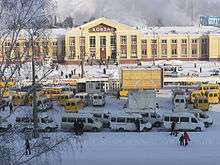
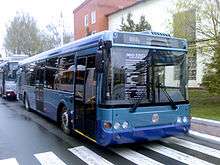
As of 2006 Russia had 933,000 km of roads, of which 755,000 were paved.[7] Some of these make up the Russian federal motorway system.
Road safety in Russia is poor with road accident deaths per million population higher than all countries in the G8 and the other BRIC countries. In 2008, the accident risk travelling on Russia's roads was 60 times that of Great Britain.[8] With a large land area the road density is the lowest of all the G8 and BRIC countries.[8] Dashcams are widespread, inasmuch as Russian courts prefer video evidence to eyewitness testimony, but also as a guard against police corruption and insurance fraud.[9]
Fleet

During Soviet times, since 1945 the import of cars to a halt, with the onset of the free car sales Soviet production. But at the same time brought into the fairly large number of trucks and buses, mainly because of the socialist countries of Eastern Europe (e.g. urban, intercity and tourist buses Ikarus, buses and trucks Skoda, trucks Industriewerke Ludwigsfelde, Robur, Tatra, LIAZ, Praga V3S, Csepel, Avia, ZSD Nysa passenger vans, Zuk cargo vans). At the same time they were imported and from the capitalist countries (OAF trucks in the late 50s, tractors from Volvo and Mercedes-Benz NG in 1970-1980 for Sovtransavto, organization engaged in international road transport, the party tractors Unic-Fiat in the middle 1970s for the Leningrad port, dump trucks Unit Rig in 1979-1983, dump trucks International Harvester Paystar and concrete mixers on their base for the construction of irrigation canals, dump trucks Berliet T60 in 1969 to open the mine and ore processing plant of Ai in the Orenburg Oblast, ballast tractors Fawn in 1970-1980's, dump trucks Komatsu since 1979; bonneted flatbed trucks and dump trucks Magirus, since 1975 for the construction of Baikal–Amur Mainline (BAM)).
By the 1980 Summer Olympics in Moscow, priority was given to smaller cars such as the Mercedes-Benz S-Class W116 to work as police cars and taxis for tourists, as well as on the basis of reanimating the sales of vans of the same brand.
Nevertheless, the leading place in the transportation within the country was occupied by Soviet-made cars (passenger cars Moskvitch, GAZ-M20 Pobeda, GAZ, ZiL, VAZ, Izh, ZAZ, jeeps UAZ, LuAZ, vans RAF, ErAZ, trucks GAZ, Kamaz, ZiL, MAZ, KrAZ, UralAZ, BelAZ, KAZ (Colkhides), buses KAvZ, PAZ, LiAZ, LAZ, trolleybuses ZiU).
In 1988, together with the resolution of business, was allowed free sale of trucks and buses.
Since the 1990s, there was a massive import of cars, second-hand first, and then the new.
In the 2000s, foreign companies began to massively build factories in Russia, or to enter into agreements with existing assembly plants.
Currently, the European and Asian parts of Russia as different fleet. In the European part of the new cars mostly Russian, European, Japanese, American, Chinese; on the Asian side are mainly used Japanese cars, it is often a model for the Japanese domestic market (the largest proportion in Vladivostok).
The largest share of Russian car brands in the North Caucasus (e.g. Dagestan and Chechnya).
The same attitude on the trucks. Recently, European and Chinese trucks brands in the Russian pushed long haul, although the position of Russian in the short and middle transport remain.
Park marshrutkas (fixed-route taxi) are vehicles of the Russian model GAZelle, as well as minibuses, converted from cargo vans of European brands (Ford Transit, Peugeot Boxer, Fiat Ducato, Renault Master, Iveco Daily, Mercedes-Benz Sprinter, Volkswagen Crafter) on special Russian companies that are licensed by the manufacturer. Also operate small buses Russian (PAZ), Ukrainian (Bogdan, South Korean (Hyundai County) and Chinese brands(BAW). Usually owned by a limited liability company or individual entrepreneurs, while in Moscow, along with private and state also exist, painted in a single color.
City buses, are represented mainly by Russian brands (PAZ, KAvZ, LiAZ, MARZ, NefAZ, Volzhanin) and Belarusian MAZ. Buses of European production are mostly in Vladivostok (51 buses MAN A78 Lion's City LE, Moscow (1 bus Mercedes-Benz Turk O345 Connecto LF, 4 buses Ikarus 435, 71 buses Scania OmniLink of Russian assembly, 1 bus MAN A23 Lion's City GL, Kolomna (16 buses Mercedes-Benz Turk O345 Connecto H,1 bus Mercedes-Benz Türk O345 Conecto LF), St. Petersburg (16 buses MAN Lion's Classic, 52 buses Scania OmniLink). In other cities also work used German, Swedish, Finnish, Dutch coaches production of 80–90 years and the new Chinese. The most successful enterprises of public transport in Moscow, Kolomna, St. Petersburg, Sochi and Kazan (which in 2007 was held the most successful reform of the bus transport with a full upgrade of the park, the prohibition of exploitation in the city). In July 2014 the Prime Minister Dmitry Medvedev issued a decree banning purchases of foreign techics (included public transport)for state and municipal needs.
Intercity buses Chinese, Korean and Russian brands. At the same time, large companies for their service needs are buying European buses.
Became popular gray import, which involved special dealers. Basically entered cars or American brands for the USA market (such as Ford Mustang, Lincoln Town Car, Ford F-Series, Dodge Viper, Toyota Sienna, Toyota 4Runner). Sometimes, after analyzing these sales by manufacturers begin official sales (so began selling cars Acura, Toyota Highlander, Toyota Venza, Infiniti, Chevrolet Corvette, Chevrolet Camaro).
In the same way the American imported trucks (mainly long-range tractors) that despite this popular in Russia. In Russia reach trucks from brands like Freightliner, International, Peterbuilt and Volvo models for United States market. In late 2013 International he started his own office and started formal sale of the tractor International ProStar in a special version for Russia. In 2014, due to begin official sales of dump trucks Western Star 6900XD.
| Availability of vehicles (end of year; thousands: According to the Federal State Statistics Service of Russian Federation)[10] | ||||||
|---|---|---|---|---|---|---|
| 1990 | 2000 | 2005 | 2010 | 2011 | 2012 | |
| trucks (including pickups and cargo vans) - total | 2744 | 4401 | 4848 | 5414 | 5545 | 5751 |
| in organizations of all kinds of economic activities 1) | 331 | 1387 | 944 | 683 | 661 | 611 |
| owned by citizens | 4 | 1568 | 2300 | 2950 | 3097 | 3273 |
| public buses 2) | 153 | 109 | 79 | 63 | 72 | 75 |
| cars - total | 8964 | 20353 | 25570 | 34354 | 36415 | 38792 |
| including the property of the citizens | 8677 | 19097 | 24125 | 32629 | 34624 | 36917 |
| trolleybuses | 13,8 | 12,2 | 11,4 | 11,1 | 11,0 | 11,0 |
| 1) For 1990 by Road Transport Organizations. Since 2000 - for organizations of all kinds of economic activities. 2) concerning road transport organizations. Since 2000 - excluding small businesses. Since 2011 - operating buses (owned, leased, purchased under a lease agreement, etc.). | ||||||
According to the Federal State Statistics Service, in 2013 the highest number of personal cars per 1000 population was in the Ural Federal District -304.1 (regions most in the Sverdlovsk Oblast -312.6), then go North-West Federal District -302.5 (by most regions in the Pskov oblast -345.3), Far Eastern Federal District -298.5 (regions most in the Kamchatka Krai -484.8), Central Federal District -284.6 (regions most in the Belgorod Oblast -340.5), Southern Federal District -274.3 (regions most in Krasnodar Krai -289.5), Siberian Federal District - 261.8 (regions most largest in the Republic of Khakassia and the Novosibirsk Oblast -by 292.5), Volga Federal District- 258.0 (regions most in the Orenburg Oblastn -298.1) and the North Caucasian Federal District -197.0 (regions most in the Stavropol Krai -267.2). Thus, the regions of the highest number in the Asian part of Russia in the Kamchatka Krai -484.8, and in the European part of the Belgorod Oblast -340.5, and the smallest in the Asian part of the Chukotka Autonomous Okrug -73.1 and in the European part of the Republic of Ingushetia -130.0.[11]
Waterways

According to the data of the Maritime Board (Morskaya Kollegiya) of the Russian Government for 2004,[12] 136.6 million tons of cargo have been carried that year over Russia's inland waterways, the total cargo transportation volume being 87,556.5 million ton-km. During same year, 53 companies were engaged in carrying passengers over Russia's inland waterways; they transported 22.8 million passengers, the total volume of river passenger transportation being 841.1 million passenger-km.
Black Sea and Sea of Azov
Novorossiysk, Rostov-on-Don, Sochi, Tuapse, Yeysk.
Baltic Sea
Baltiysk, Kaliningrad, Primorsk, St. Petersburg, Vyborg, Vysotsk.
White Sea, Barents Sea, and other seas of Arctic Ocean
Arkhangelsk, Dudinka, Igarka, Murmansk, Tiksi, Vitino.
Seas of Pacific Ocean
Kholmsk, Magadan, Nakhodka Vostochny Port, Nevelsk, Petropavlovsk-Kamchatsky, Vanino, Vladivostok
Caspian Sea
Pipelines
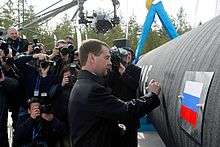
Russia is home to the world's longest oil pipeline, the Druzhba pipeline and in fact one of the biggest oil pipeline networks in the world. It carries oil some 4,000 kilometres (2,500 mi) from the eastern part of the European Russia to points in Ukraine, Belarus, Poland, Hungary, Slovakia, the Czech Republic and Germany. The network also branches out into numerous pipelines to deliver its product throughout the Eastern Europe and beyond. The name "Druzhba" means "friendship", alluding to the fact that the pipeline supplied oil to the energy-hungry western regions of the Soviet Union, to its "fraternal socialist allies" in the former Soviet bloc, and to western Europe. Today, it is the largest principal artery for the transportation of Russian (and Kazakh) oil across Europe.
On 29 October 2012 president Vladimir Putin instructed the general manager of Gazprom to start the construction of the pipeline. On 21 May 2014, Russia and China signed a 30-years gas deal which was need to make the project feasible. Construction was launched on 1 September 2014 in Yakutsk by president Putin and Chinese deputy premier minister Zhang Gaoli.[13][14]
Airports
As of 2002, there were 2,743 airports in Russia.
Aircraft manufacturing is an important industrial sector in Russia, employing around 355,300 people. The dissolution of the Soviet Union led to a deep crisis for the industry, especially for the civilian aircraft segment. The situation started improving during the middle of the first decade of the 2000s due to growth in air transportation and increasing demand. A consolidation programme launched in 2005 led to the creation of the United Aircraft Corporation holding company, which includes most of the industry's key companies. According to the Federal State Statistics Service of the Russian Federation, as of 2012, there were 6,200 civil aircraft in Russia.[10]
Airports with paved runways
total:
630 BD IS ON
over 3,047 m:
54
2,438 to 3,047 m:
202
1,524 to 2,437 m:
108
914 to 1,523 m:
115
under 914 m:
151 (1994 est.)
Airports with unpaved runways
total:
1,887
over 3,047 m:
25
2,438 to 3,047 m:
45
1,524 to 2,437 m:
134
914 to 1,523 m:
291
under 914 m:
1,392 (1994 est.)
See also
- Bering Strait bridge/tunnel
- Ministry of Transport (Russia)
- Production of urban electric transport in Russia
References
- ↑ Railway line length of various countries (Russian)
- ↑ Freight by electric railroad 2008 (Russian)
- ↑ Gov't transport statistics
- ↑ Lenta.RU News "РЖД попросила правительство заняться спасением железных дорог" (Russian) (RZhD asks government to rescue the railroad)
- ↑ Table 2.28. ПЕРЕВОЗКИ ПАССАЖИРОВ И ПАССАЖИРООБОРОТ ЖЕЛЕЗНОДОРОЖНОГО ТРАНСПОРТА ОБЩЕГО ПОЛЬЗОВАНИЯ; TRANSPORTATION OF PASSENGERS AND PASSENGER TURNOVER OF PUBLIС RAILWAY TRANSPORT Основные показатели транспортной деятельности в России - 2008 г. Copyright © Федеральная служба государственной статистики
- ↑ Table 2.25. ПЕРЕВОЗКИ ГРУЗОВ И ГРУЗООБОРОТ ЖЕЛЕЗНОДОРОЖНОГО ТРАНСПОРТА ОБЩЕГО ПОЛЬЗОВАНИЯ TRANSPORTATION OF CARGO AND FREIGHT TURNOVER OF PUBLIC RAILWAY TRANSPORT Основные показатели транспортной деятельности в России - 2008 г. Copyright © Федеральная служба государственной статистики
- ↑ Rosstat statistics on length of roads Retrieved on 10 June 2009
- 1 2 "Transport in Russia". International Transport Statistics Database. iRAP. Archived from the original on 2009-04-17. Retrieved 17 February 2009.
- ↑ Damon Lavring (15 February 2013). "Why Almost Everyone in Russia Has a Dash Cam". Wired.
- 1 2 http://www.gks.ru/bgd/regl/b13_13/IssWWW.exe/Stg/d3/17-18.htm
- ↑ http://www.gks.ru/free_doc/new_site/business/trans-sv/t3-4.xls
- ↑ Морская коллегия: Речной транспорт (Maritime Board: River Transport) (Russian)
- ↑ "Putin In Yakutsk To Inaugurate Construction Of Pipeline To China". Radio Free Europe/Radio Liberty. 1 September 2014. Retrieved 2014-09-02.
- ↑ "Putin gives start to Power of Siberia gas pipeline construction". ITAR-TASS. 1 September 2014. Retrieved 2014-09-02.
External links
- "Russian, CIS and Baltic Railway Map". Archived from the original on 8 Dec 2012. (with place names in Russian, but legend in English).
- Search Engine of Russian intercity buses
- Search Engine of Moscow city transport. This engine provides the fastest and the most comfortable routes of Moscow's transport with detailed information about every route.
- Russian Transport Daily Report
_(5083807053).jpg)



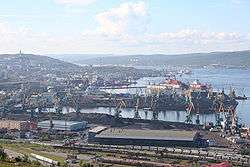
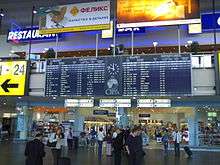
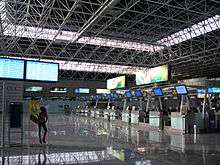
_over_Italy.jpg)

